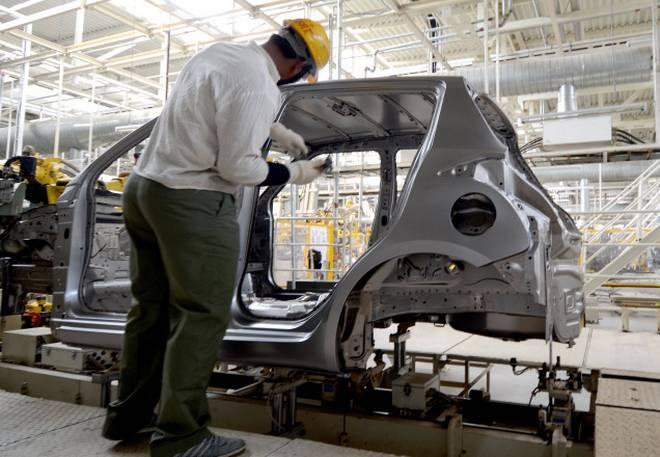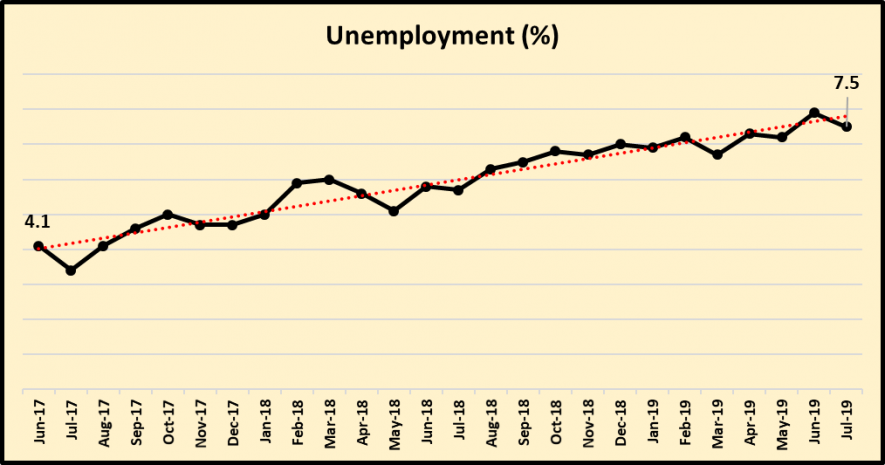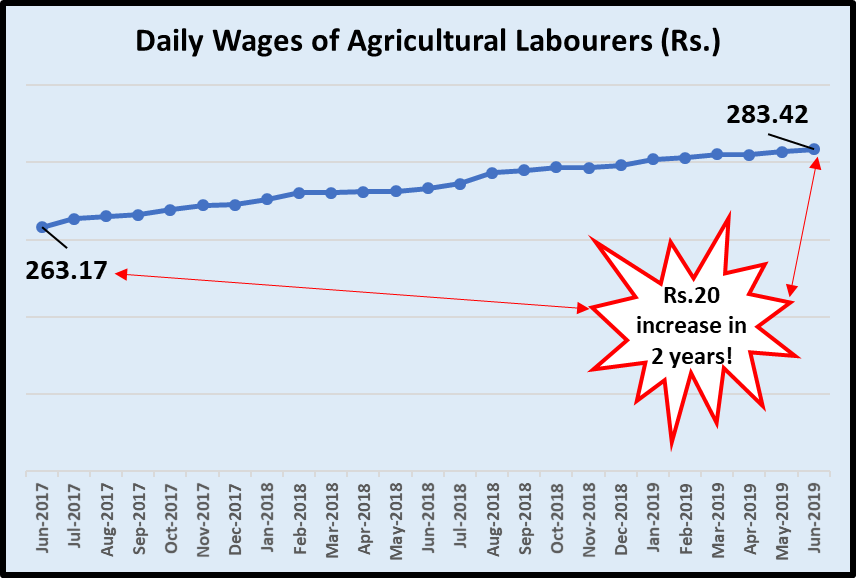What the Slowdown Means for Working People

Image for representational use only.Image Courtesy : The Hindu
There is much huffing and puffing, and hand wringing, going on in the increasingly panicked corporate sector as the Indian economy stutters and falters. After his Independence Day address, Prime Minister Modi went straight to a “brainstorming” meeting with Finance Minister and the mandarins of her ministry. Earlier, Sitharaman had been busy holding endless meetings with – don’t hold your breath - bankers, industry captains, capital market players and real estate tycoons. Even foreign portfolio investors were given an audience since they were worried about the surcharge on their incomes. The mainstream media, of course, has gone ballistic with speculation about a stimulus package (read concessions) including tax breaks.
Not surprisingly, the narrative being built up by the media, following the lead from the Modi government itself, is that these ‘wealth creators’ are the ones that are suffering and they need help. In fact, Modi himself defended them in his address from Red Fort.
But there is deafening silence on what will happen to the people – the agricultural and industrial workers, the small and marginal farmers, employees, indeed, even the middle class. In the scramble to resolve the economic crisis, Modi and his colleagues have not consulted any body from these sections and neither is there any talk of measures for helping the people.
It is in this approach that the govt. is committing a lethal error, for which the people will have to pay heavily in the coming months. The govt. is trying to boost private sector investment by giving them more concessions whereas the real problem is that there is a demand slump. People do not have buying power in their hands. The way out would be to boost demand by – increasing agricultural and non-agricultural wages, increasing farmers’ incomes by strengthening public procurement at higher prices and increasing govt. spending to kick start economic activity. However, these measures are anathema to the Modi govt. as they were to previous Congress govts. (note that P.Chidambaram, Congress leader and former finance minister welcomes some of the measures declared by Modi!).
Meanwhile, have a look at what the people of the country – the real wealth creators, not parasitical corporate bigwigs – are going through.
Wave of Job Losses
As demand slows down, many industrial and services sectors are facing a crunch which they are facing up to by getting rid of workers. Concrete figures are available only from the automobile sector and its ancillaries, which suggest that up to 10 lakh jobs may be lost as automobile sales slumped, leading to downstream slumps in auto parts makers and various ancillary units. Over 300 dealerships have reportedly shut down.
Besides this, the fast moving consumer goods (FMCG) sector is facing a crisis. Hindustan Lever, a leading company has posted a growth of 5.5% in the first quarter this year compared to 12% last year. Various other companies whose results are available, like Britannia, Dabur, Asian Paints etc. are reportedly showing similar strains. What will happen there is the same thing – more retrenchments and lay offs of workers while contractual workers will get simply dismissed.
The real estate and construction sector employs about 12% of the workforce and has served as a cushion for pauperised peasants and agricultural labour. But inventories of unsold units stand at a staggering 42 months (normal is 8-12 months). The sector links to 250 types of ancillary industries Clearly this sector too is going through a massive slump which will mean loss of lakhs of jobs – unless the govt. picks up the slack by boosting public investment.
Big steel companies like Tata Steel have declared a cutback in capital investment because of slowing demand. Lay offs are expected in many of the industrial units according to reports.
The micro, small and medium enterprises (MSME) sector, a big employment source, has never recovered from the twin shocks of demonetisation and GST. In recent months it has slipped further. Bank credit data put out by RBI shows that lending to MSME has actually slipped from 0.7% in 2018 to 0.6% in the first quarter of this fiscal year. This means that more jobs are going to be lost in the coming days.
Even the services sector is slowing down, unlike earlier. Bank credit has declined in tourism, hotel and restaurants, IT, transport, real estate and shipping. This is an indication that employment in these sectors is likely to dip.
Raging Unemployment
The job losses are occurring in the background of an ongoing unemployment crisis that has been unaddressed – and unacknowledged – by the Modi govt. since its previous five-year term. Currently, CMIE estimates suggest that the unemployment rate stood at 7.5% in July 2019. Two years ago it was 4.1%. Joblessness has been steadily rising over this period. [See chart below]

With the current slowdown, an already dire situation will turn explosive. The numbers will become clear in the coming months. But the Modi govt. is still relying on their cronies, the private sector, to turn around things. Even when the crisis had not hit industry, they were not generating jobs. How are they going to save jobs in the present slowdown?
The Modi govt. thinks that by easing labour laws, allowing more hire and fire, and allowing wage depression, employers will employ more people. But that has not happened before, and it is impossible now. All that it will lead to is thousands getting thrown out.
Rural Distress Continues
What about the vast rural areas and agriculture? Things are even more dire in this already crisis ridden sector which gives employment – and hence buying power – to over 50% of India’s population.
Kharif sowing has dipped by about 5.3% compared to last year and for the major crop paddy it has slipped by 13%, according to latest estimates of the agriculture ministry. The ongoing floods have damaged thousands of hectares of standing crops, with likelihood of further damage as heavy rainfall and flooding is predicted in northern states like Punjab in the coming days. So, output is likely to be negatively affected.
The stingy government has announced a meagre hike in Minimum Support Prices of kharif produce. Paddy MSP, for example has been increased by just 4% over last year. In many states the cost of production is actually higher. Overall, the MSP does not meet the much-needed benchmark of cost+50% where cost includes not just inputs and family labour but also land related costs.
So, the government is unwilling to transfer resources to farmers – a policy that would have certainly jacked up demand in rural areas and helped the economy.
As far as the poorest and most exploited section of the agricultural economy, the agricultural labourers, are concerned, they have been out of sight of the govt. for a long time despite the fact that there are nearly 15 crore such workers in the country. Wages of these hapless workers have grown by a mere 3.8% over the past two years while the Consumer Price Index for Agricultural Workers increased by just over 4% in the same period, as per RBI data. This means that inflation is wiping out the meagre gains – the real wages are declining. [See chart below]

Far from injecting much needed money into the rural sector by increasing wages and enforcing them, the govt. has refused to consider the plight of agri-workers. No wonder, demand is so depressed in the rural areas.
Wages of Industrial Workers
The attitude of the Modi govt. towards workers and employees is so hostile that it has amended labour laws to remove any reasonable standards for fixing wages and working-hours. This is evident in the recently passed Code on Wages and the Code on Safety, Health and Working Conditions.
In fact, the labour minister announced that the new revised national floor level minimum wage would be Rs.178 per day, up from Rs.176 per day. This level is less than a third of what the govt. has accepted as the minimum wage for its employees, based on a well-settled norm, ratified by the Indian Labour Conference sessions and even the Supreme Court.
Barring two states, in all the other states of the country, minimum wages fixed by the respective state govts. are less than 50% of the Rs.18,000 that these norms would require. Now with the green signal from the govt., wage hikes can be forgotten by the workers.
With this approach of keeping working people at starvation wages, all the concessions to corporates and big traders, and big landowners, will not help any economic revival. In fact, it will sink the economy further.
Modi and his trusted Amit Shah are perhaps hoping that religious fervour, pseudo-nationalism and jingoism will keep the people quiescent – preoccupied with Kashmir, and Pakistan, and Ram Mandir etc. But the way economic distress is spreading they could be in for a rude shock. It is unlikely that people will continue to sing hymns while they are starving, as the old Hindi saying goes.
Get the latest reports & analysis with people's perspective on Protests, movements & deep analytical videos, discussions of the current affairs in your Telegram app. Subscribe to NewsClick's Telegram channel & get Real-Time updates on stories, as they get published on our website.
























